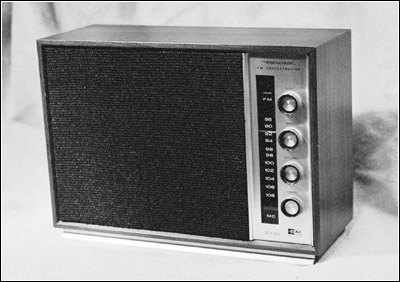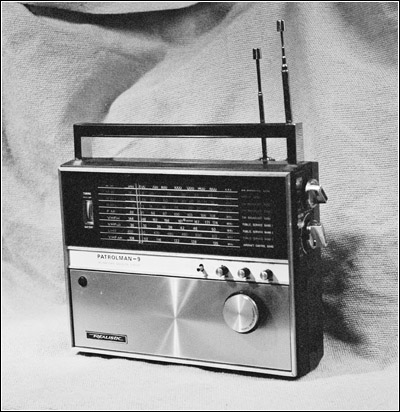Of Old Radios And Related Items--Published Monthly
Realistic Radios -- One for the Home
and One More for the RoadBY ANDREW HAYDEN
Web Edition
Focusing on two models, Andrew Hayden describes how a particular brand can catapult a company into retailing success. He suggests that the RadioShack Realistic brand of radios has become increasingly worthy of collector attention. (Editor)
From the 1950s through the 1990s, RadioShack's Realistic brand of radios helped to build the company into the largest electronics retailer of the 20th century. Hundreds of models were offered through the years, from pocket transistors and portables to table radios. Realistic made a model to suit almost any customer anywhere.
Here I have chosen two of the best radios the company offered -- the FM-only, hi-fi Concertmaster tabletop for the home and the Patrolman 9 top-shelf, multiband portable for traveling. Both models were manufactured in Japan, as RadioShack was among the first retailers to outsource production on a large scale going back as early as the late 1950s.
Things were happening in those early days. New stores were popping up daily. There were 500 outlets in 1969, 1000 by 1972, over 2000 by 1974, and the number just kept growing, reaching some 7,000 stores across the country by the 1980s! Though it's just a guess on my part, I'd say it's safe to say that many millions of Realistic brand radios were sold during this time period.
Figure 1. The RadioShack Realistic FM Concertmaster was an early entry in the FM-only radio market.The Realistic FM Concertmaster
For the home, the FM-only radios were the connoisseur's choice for listening to such events as live classical music concerts. However, I believe the FM Concertmaster, shown in Figure 1, was among the very few sets ever offered by RadioShack to receive FM signals only. I've seen a couple of smaller models from the early 1960s.
The Realistic high-fidelity Concertmaster is a commanding, solid-state, tabletop radio. When introduced in the fall of 1968, it was described in the RadioShack catalog as follows: "Better, bigger, more beautiful than any FM-only radio ever built, the brilliant new Realistic FM Concertmaster is dedicated to people who take their music listening seriously."
Offered in 1969 and 1970 for $69.95, the Concertmaster was designed to compete against the FM-only KLH Model 21 and the Scott Model 100, but at a cost of about $20 less. Previously, RadioShack itself had sold the KLH Model 21, but now it had its own hi-fi FM-only radio.
The Concertmaster cabinet construction is 1/8" plywood with oiled walnut veneer trimmed with a thick brushed aluminum faceplate and an extruded horizontal base. It measures some 14" x 10" x 5" and weighs a hefty 10 pounds. The appearance reflects the late 1960s minimalist design, clean and linear -- no ornamentation here.
As described in its literature, the Concertmaster has a "Euphonica air suspension speaker system" with a 6-inch woofer and a 3-inch tweeter. An acoustic suspension speaker relies on a cushion of air created within a sealed cabinet, instead of the standard mechanical spring suspension seen in other speakers. Features include a tuning meter, automatic frequency control, and separate bass and treble adjustments. Figure 2 (see print version) shows a close-up view of the Concertmaster controls. It is, indeed, one nice radio, having very solid bass response with substantial audio presence.
Figure 3. The Realistic Patrolman 9 tunes the AM, FM, SW, VHF and UHF bands.In fact, I think the Concertmaster actually seems more comfortable reproducing lower frequencies than the highly regarded KLH 21, and the overall fidelity is excellent. It seems as though FM-only radios, while never selling in large numbers, faded into obscurity and were not offered again by RadioShack after the 1970 season, except for a small FM "Deskube" offered in the mid-1970s for $16.95.
The Realistic Patrolman 9
Realistic's prime choice for multiband listening while on the go in 1975 was the Patrolman 9, a 9-band portable. Its advertising proclaimed, "Our finest portable lets you hear it all!" It picks up AM, FM with automatic frequency control, 450-470 MHz UHF, 147-174 MHz VHF high, 30-50 MHz VHF low, 108-135 MHz Aviation, 1.6-4 MHz Marine, 4-12 and 12-22 MHz shortwave. Figure 4 (see print version) shows the large slide-rule dial and the front panel controls. Features include twin antennas, one for UHF, one for shortwave, FM and VHF. Controls are side-mounted band selectors, shown in Figure 5 (see print version), all-band tuning (fast and slow), BFO for code reception, squelch control for silent standby, tone control, dial light and a battery/tuning meter. The radio operates on either its internal AC cord or 4 "C" cell batteries.
The size of the Patrolman 9 seems just right with dimensions of 12" x 11" x 4". The sturdy black plastic case has a stainless steel mesh lower grille and aluminum trim. The fit and finish are very nice. Its appearance, like that of the FM Concertmaster, is clean and crisp with its design based on horizontal and vertical surfaces.
At $149.95 the Patrolman 9 was a pricey radio when offered by RadioShack from 1975 to 1977. While not in the same league as a Zenith Trans-Oceanic, this Patrolman 9 is very capable, pulling in stations rather well, while its audio quality from a 4-inch speaker is quite good.
In all, Realistic choices for multiband portables was vast and varied, with several in the $50 range. The 6-band models at $100 were popular (see A.R.C., Oct. 2004).
The End of a Brand
The two offerings under the Realistic brand name discussed here, and shown side by side in Figure 6 (see print version), are from what many consider RadioShack's golden era of bringing innovation to market -- great products at great prices. The Realistic name was phased out in the early 1990s and appears to have largely disappeared from the company catalog by 1995. Nostalgia for the brand seems to have begun with collector prices on the better radios climbing in recent years, but resourceful collectors can find them for a song. It's worth the search -- they are nice radios.
References:
Farman, Irvin. Tandy's Money Machine. Chicago: The Mobium Press, 1992.
RadioShack catalogs online. www.RadioShackcatalogs.com.
Stadler, Charles. "Transistorized Multiband Portable Radios," Antique Radio Classified, October 2004.
Andrew Hayden is interested in the history of electronics companies. His RadioShack company profile appeared in the February 2007 issue of A.R.C. He has collected and researched vintage KLH equipment for over ten years.
Article as PDF: Realistic Radios -- One for the Home and One More for the Road
|
[Free Sample] [Books, etc., For Sale] [Subscribe to A.R.C./Renew] [Classified Ads] [Auction Prices] [Event Calendar] [Links] [Home] [Issue Archives] [Book Reviews] [Subscription Information] [A.R.C. FAQ]URL = http://www.antiqueradio.com/Mar09_Hayden_RealisticRadios.html Copyright © 1996-2009 by John V. Terrey - For personal use only. Last revised: February 28, 2009. For Customer Assistance please contact ARC@antiqueradio.com or call (866) 371-0512 toll free Pages designed/maintained by Wayward Fluffy Publications Antique Radio Classified |

